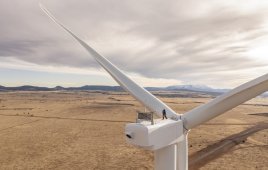Electrical pitting and erosion, failure modes common in the wind-energy industry, occur in bearings on generators in wind turbines. The failure modes are caused by stray current passing through the bearing. The current arcs from one surface to another to find a ground. So as current goes through the bearing outer ring, it arcs from the raceway to a ball, then to the inner-ring raceway, and finally through the shaft to ground. Arcing causes damage to the raceway surface by heating up the arc point on the surface and fusing the material.
One way around the problem, says Peter Lorentz, Senior Product Analysis Engineer at NTN Bearing Corp. of America

The race damage in both cases above is attributed to stray current from an improperly grounded generator. Electricity takes the path of least resistance, and sometimes that is through a bearing.
, Mt. Prospect, Ill, is with the company’s MEGAOHM Series of bearings. They have a ceramic coating on their outer surfaces of the outer ring to insulate the bearing from stray current, thus eliminating the potential for electrical damage to raceways and rolling elements.
Lorentz says the electrical damage appears in two forms. When dynamic electrical damage occurs on a rotating bearing, the race shows evenly spaced arcs (left in the picture). In the second, static electrical damage occurs when the bearing is not rotating and a current discharge passes through the bearing. Then damage appears as a molten pool of metal similar to that of a weld bead (right side of the picture).
Either form of damage eventually results in noise, or vibration, or both, and shortens the bearing life. Of course, decreased bearing life increases turbine downtime for repairs and reduces the overall efficiency of the wind farm.
The crack-resistant coating on MEGAOHM bearings has an insulation resistance of at least 2,000 M-ohm under normal operating temperatures. Lorentz says the bearings are interchangeable with standard bearings and offer significant cost benefits to alternative hybrid ceramic-ball bearings. NTN says it has a long history of using MEGAOHM bearings in OEM wind turbines and other applications.
Filed Under: Bearings, Components, Turbines




